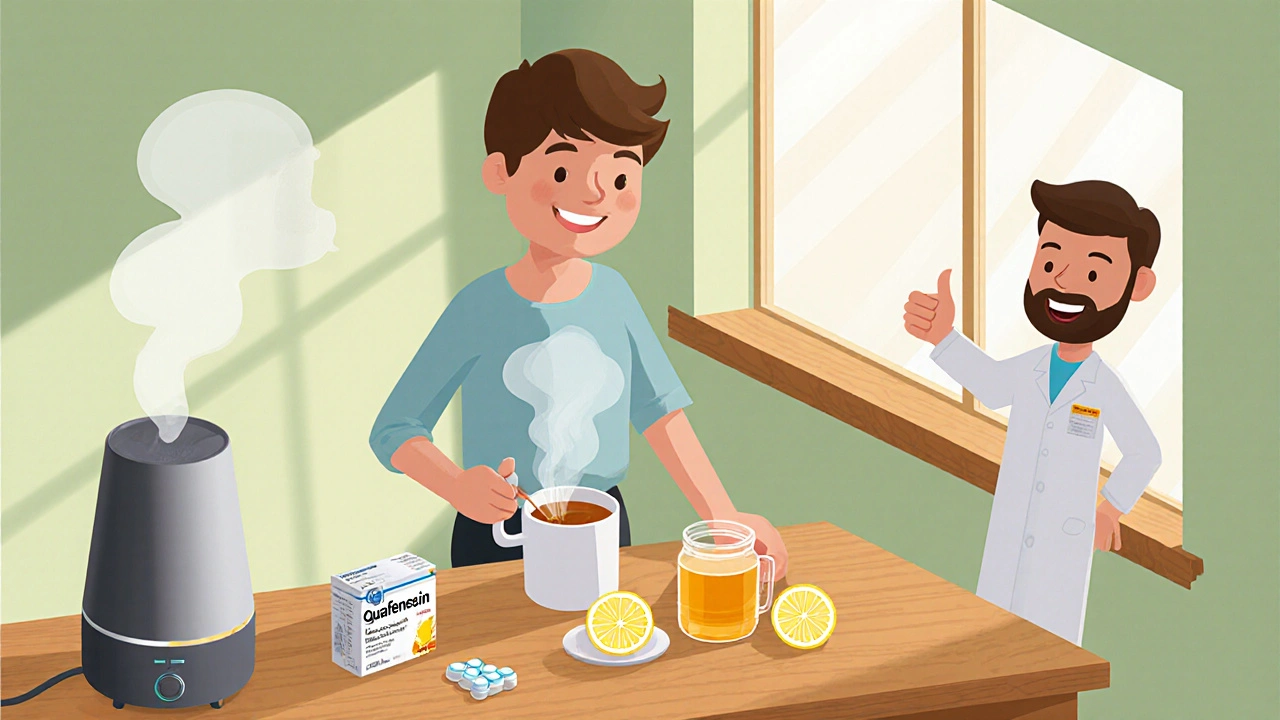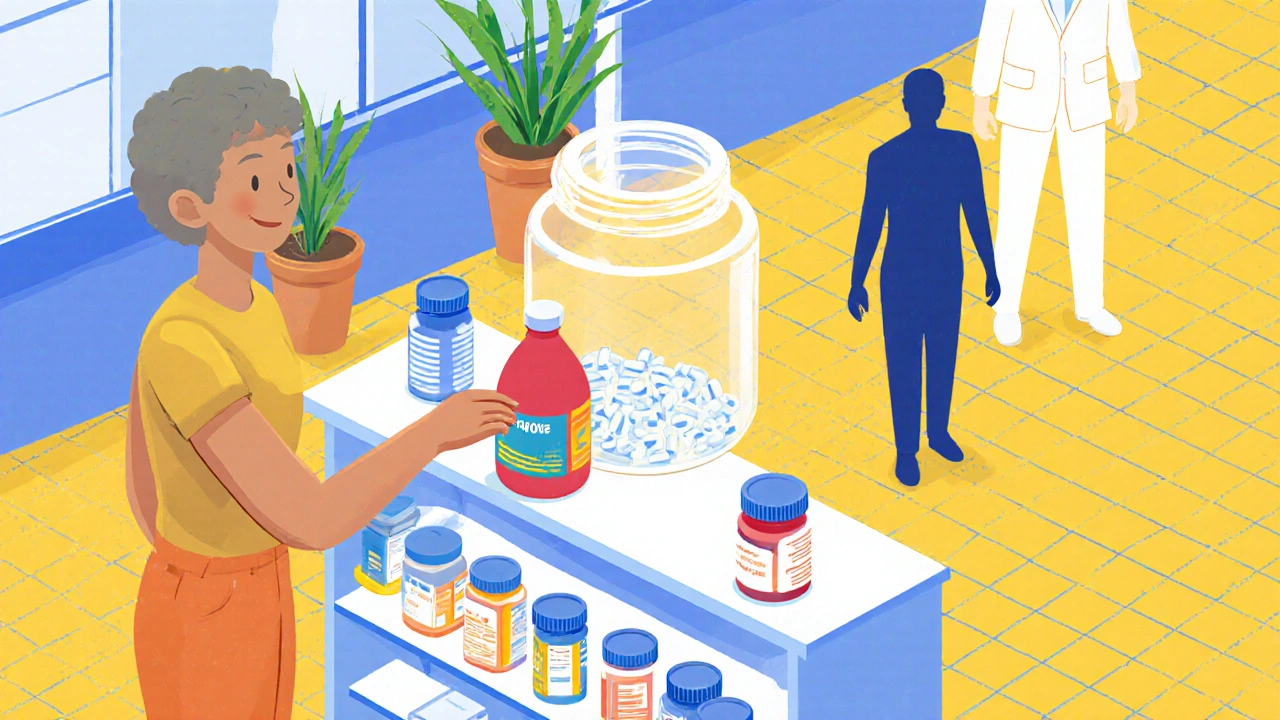MAOI Washout Calculator
Enter the date you stopped taking your MAOI antidepressant to determine when it's safe to take dextromethorphan-containing products. The FDA and medical guidelines recommend a minimum 14-day washout period to avoid serotonin syndrome.
Current Date
Safe Date
Note: This tool calculates the minimum washout period of 14 days. Some healthcare providers may recommend waiting longer for full safety.
Key Takeaways
- Combining dextromethorphan with any monoamine oxidase inhibitor (MAOI) can trigger serotonin syndrome, a potentially fatal condition.
- Serotonin levels can spike within 6‑24 hours of co‑administration, producing fever, rigidity, confusion and dangerous blood‑pressure spikes.
- Patients must wait at least two weeks after stopping an MAOI before taking any dextromethorphan‑containing product.
- Pharmacist counseling cuts accidental combos by two‑thirds; always tell your prescriber about OTC cough medicines.
- Safer cough‑relief options for MAOI users include plain guaifenesin, honey‑lemon mixtures, or prescription‑only alternatives.
When you reach for a bottle of cough syrup, you probably don’t think about your antidepressant. Yet the over‑the‑counter (OTC) drug Dextromethorphan is a centrally acting cough suppressant that also modestly inhibits serotonin reuptake and can clash brutally with Monoamine oxidase inhibitors (MAOIs). This article untangles why the combo is risky, how to spot the warning signs, and what safer routes look like.
Why the Interaction Happens
Both dextromethorphan and MAOIs end up raising serotonin-the brain’s mood‑lifting messenger. MAOIs block the enzyme monoamine oxidase, which normally breaks down serotonin, norepinephrine, and dopamine. At the same time, dextromethorphan’s weak serotonin‑reuptake inhibition means more serotonin stays in the synapse. The result? An overload that can tip into Serotonin syndrome, a cascade of autonomic and neuromuscular disturbances.
Adding another layer, dextromethorphan is cleared mainly by the liver enzyme CYP2D6. Certain MAOIs, especially the older irreversible ones, slow CYP2D6 activity, sending dextromethorphan levels soaring-studies report a 300‑400 % increase in plasma concentration. Higher blood levels mean stronger serotonin reuptake blockade, amplifying the danger.
How Serious Is Serotonin Syndrome?
Serotonin syndrome ranges from mild agitation to life‑threatening hyperthermia. The 2022 PMC review found mortality rates of 2 %‑12 % in severe cases. Typical symptoms appear within 6‑24 hours after the drugs are taken together and include:
- Rapid heart rate and high blood pressure (hypertensive crisis)
- Fever > 104 °F (hyperpyrexia)
- Muscle rigidity, tremor, or clonus
- Confusion, agitation, or seizures
- Dilated pupils and sweating
When these signs surface, emergency care is non‑negotiable. Intravenous 5‑HT2A antagonists such as chlorpromazine, plus aggressive cooling and supportive measures, are the mainstays of treatment.

Which MAOIs Are Most Problematic?
All MAOIs carry risk, but the irreversible, non‑selective agents are the biggest culprits. Below is a quick snapshot.
| MAOI | Brand Examples | Risk Level with Dextromethorphan |
|---|---|---|
| Phenelzine | Nardil | High - many reported cases |
| Tranylcypromine | Parnate | High - similar to phenelzine |
| Selegiline | Zelapar, Emsam | Moderate - transdermal route still risky |
| Moclobemide | Manifax | Lower - reversible, fewer reports |
Even the “lower‑risk” reversible MAOIs aren’t exempt; clinicians still advise a two‑week washout before any dextromethorphan use.
Practical Safety Steps for Patients
- Check the label. Look for the active ingredient “dextromethorphan” or brand names such as Robitussin, Delsym, NyQuil Cough, etc.
- Know your antidepressant. If you’re on phenelzine, tranylcypromine, selegiline, rasagiline, or any MAOI, treat all cough syrups as off‑limits.
- Observe the 14‑day rule. After stopping an MAOI, wait at least two weeks before taking any product containing dextromethorphan.
- Ask your pharmacist. A quick conversation can catch hidden dextromethorphan in combination cold medicines or multi‑symptom tablets.
- Know the red flags. Fast‑rising fever, severe muscle stiffness, agitation, or sudden hypertension after taking a cough remedy warrants emergency care.
Evidence from a 2021 Journal of the American Pharmacists Association study shows that when pharmacists proactively screened MAOI patients, accidental combos fell by 67 %.
Safer Alternatives for Cough Relief
If you’re on an MAOI, steer clear of any dextromethorphan‑containing product. Consider these options:
- Guaifenesin - an expectorant that thins mucus without affecting serotonin.
- Honey‑lemon tea - soothing, low‑risk, and backed by modest clinical data for cough frequency.
- Prescription cough suppressants such as codeine (if not contraindicated) after a doctor’s assessment.
- Non‑pharmacologic measures - humidifiers, throat lozenges without dextromethorphan, and staying hydrated.
Even natural products can contain tyramine, which interacts with MAOIs, so read ingredient lists carefully.

Regulatory Landscape and Labeling Gaps
The FDA has required a specific MAOI warning on all dextromethorphan OTC labels since 2010, yet a 2021 safety analysis found only 38 % of products displayed the warning prominently. In the United States, roughly 1.2 million people use MAOIs annually, while dextromethorphan sales top $1.4 billion. The mismatch fuels accidental exposures.
Recent moves aim to tighten warnings. The FDA’s 2022 proposal-now slated for implementation in Q3 2024-calls for larger, high‑contrast alert boxes and explicit brand‑name listings. European Medicines Agency guidance (2023) also mandates printed patient medication guides that name common cough syrups.
What to Do If You Suspect an Interaction
Time is critical. If you, or someone you’re caring for, shows serotonin‑syndrome signs after taking a cough medicine while on an MAOI, follow these steps:
- Call emergency services (911 in the US, 999 in the UK).
- Inform the dispatcher that the patient is on an MAOI and has taken dextromethorphan.
- Do not give any other medications unless instructed by a medical professional.
- Stay with the patient; note the time of the last dose of each drug.
Hospitals will typically administer IV benzodiazepines for agitation, cool the patient, and consider specific serotonin antagonists if the syndrome is severe.
Bottom Line
For anyone on an MAOI, dextromethorphan is a red‑flag OTC ingredient. The combination can spark serotonin syndrome within a day, and the stakes include high fever, dangerous blood‑pressure spikes, and even death. By checking labels, respecting the two‑week washout, and leaning on pharmacists, you can keep your cough under control without risking a life‑threatening reaction.
